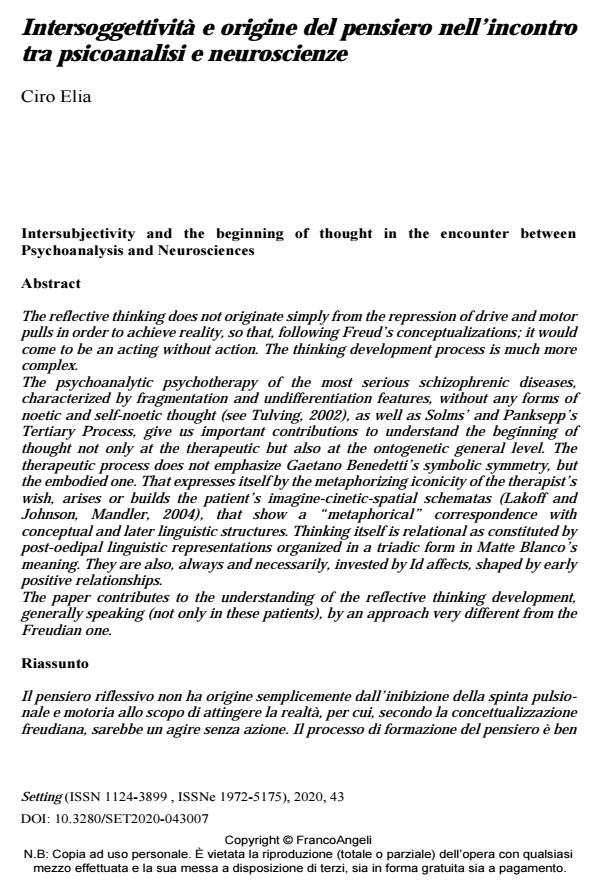Intersubjectivity and the beginning of thought in the encounter between Psychoanalysis and Neurosciences
Journal title SETTING
Author/s Ciro Elia
Publishing Year 2020 Issue 2020/43
Language Italian Pages 4 P. 119-122 File size 164 KB
DOI 10.3280/SET2020-043007
DOI is like a bar code for intellectual property: to have more infomation
click here
Below, you can see the article first page
If you want to buy this article in PDF format, you can do it, following the instructions to buy download credits

FrancoAngeli is member of Publishers International Linking Association, Inc (PILA), a not-for-profit association which run the CrossRef service enabling links to and from online scholarly content.
The reflective thinking does not originate simply from the repression of drive and motor pulls in order to achieve reality, so that, following Freud’s conceptualizations; it would come to be an acting without action. The thinking development process is much more complex. The psychoanalytic psychotherapy of the most serious schizophrenic diseases, characterized by fragmentation and undifferentiation features, without any forms of noetic and self-noetic thought (see Tulving, 2002), as well as Solms’ and Panksepp’s Tertiary Process, give us important contributions to understand the beginning of thought not only at the therapeutic but also at the ontogenetic general level. The therapeutic process does not emphasize Gaetano Benedetti’s symbolic symmetry, but the embodied one. That expresses itself by the metaphorizing iconicity of the therapist’s wish, arises or builds the patient’s imagine-cinetic-spatial schematas (Lakoff and Johnson, Mandler, 2004), that show a "metaphorical" correspondence with conceptual and later linguistic structures. Thinking itself is relational as constituted by post-oedipal linguistic representations organized in a triadic form in Matte Blanco’s meaning. They are also, always and necessarily, invested by Id affects, shaped by early positive relationships. The paper contributes to the understanding of the reflective thinking development, generally speaking (not only in these patients), by an approach very different from the Freudian one.
Il pensiero riflessivo non ha origine semplicemente dall’inibizione della spinta pul-sionale e motoria allo scopo di attingere la realtà, per cui, secondo la concettualiz-zazione freudiana, sarebbe un agire senza azione. Il processo di formazione del pen-siero è ben più complesso e la terapia psicoanalitica delle forme più gravi di schizo-frenia, disorganizzate e indifferenziate, nelle quali non vi è assolutamente pensiero noetico e auto noetico (Tulving, 2002) o il Processo Terziario di Solms e Panksepp, fornisce dei contributi importanti alla comprensione dell’origine del pensiero non solo in ambito terapeutico ma in generale nell’ontogenesi. Il processo terapeutico non pone qui in primo piano la simmetria simbolica di Bene-detti ma la simmetria corporea. Questa, che si esprime attraverso l’iconicità metafo-rizzante e desiderante del terapeuta, risveglia o costituisce gli schemi-immagine ci-netico-spaziali (Lakoff e Johnson, Mandler, 2004) del paziente, che hanno una cor-rispondenza "metaforica" con le strutture concettuali e poi linguistiche. Il pensiero è relazionale in quanto costituito da rappresentazioni verbali post-edipiche, organizzate triadicamente nel senso di Matte Blanco, investite sempre e necessariamente degli affetti dell’Es, ma modulati nell’ambito di una precedente re-lazionalità buona. Il mio contributo vuole favorire la comprensione dello sviluppo del pensiero rifles-sivo in senso generale (non solo in questo tipo di pazienti) secondo una visione mol-to diversa da quella di Freud.
Ciro Elia, Intersoggettività e origine del pensiero nell’incontro tra psicoanalisi e neuroscienze in "SETTING" 43/2020, pp 119-122, DOI: 10.3280/SET2020-043007